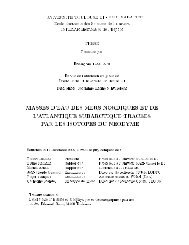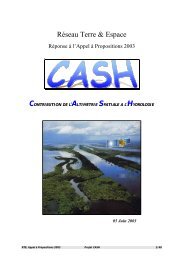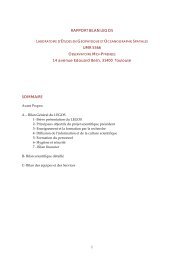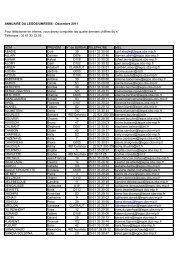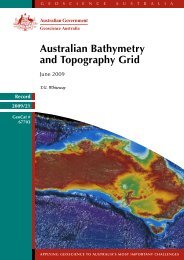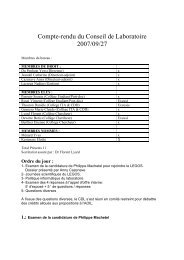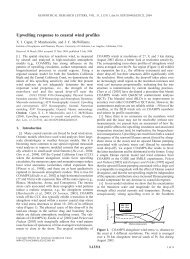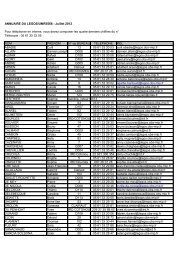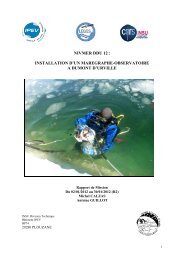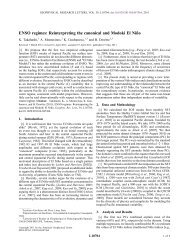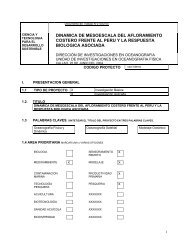Chaigneau and Pizarro - LEGOS
Chaigneau and Pizarro - LEGOS
Chaigneau and Pizarro - LEGOS
You also want an ePaper? Increase the reach of your titles
YUMPU automatically turns print PDFs into web optimized ePapers that Google loves.
C05014 CHAIGNEAU AND PIZARRO: CIRCULATION OF THE EASTERN SOUTH PACIFIC<br />
Figure 4. Spatial distribution of eddy kinetic energy from (a) drifter data <strong>and</strong> (b) satellite altimeter<br />
measurements of TP/ERS. Bold lines show the SPC, SEC, <strong>and</strong> PCC.<br />
the tracer evolution. In a Lagrangian frame, the most<br />
common is that the velocity field can be decomposed in a<br />
mean flow U =(U, V) representative of large spatial scale,<br />
<strong>and</strong> in a turbulent mesoscale flow u 0 =(u 0 , v 0 ) computed<br />
following the fluid particles [Poulain <strong>and</strong> Niiler, 1989;<br />
Bauer et al., 1998, 2002; Kundu <strong>and</strong> Cohen, 2000]. Thus<br />
the mean current U is determined by averaging the velocity<br />
components over each drifter trajectory. The main properties<br />
of the turbulent velocity field u 0 are the Lagrangian integral<br />
time <strong>and</strong> length scales (T <strong>and</strong> L, respectively), which<br />
represents the time <strong>and</strong> the distance over which a particle<br />
remembers its path.<br />
[26] For each component of the turbulent velocities (u 0 , v 0 ),<br />
we can determine a temporal scale T =(T u, T v) by integrating<br />
the respective velocity autocovariance function R =(R u, R v)<br />
to its first zero crossing G [Taylor, 1921]:<br />
T ¼ 1<br />
Rð0Þ<br />
Z G<br />
0<br />
RðtÞdt:<br />
8of17<br />
C05014<br />
The Lagrangian autocovariance functions Ru (t) =<br />
u0ðÞu t 0ðtþtÞ <strong>and</strong> Rv (t) =v0ðÞv t 0ðtþtÞ (here the overbar<br />
denotes ensemble average) were determined for each drifter<br />
spending more than 20 days in the domain <strong>and</strong> averaged in<br />
time. A total of 353 drifter trajectories, assumed to be<br />
independent, were then used to calculate this mean<br />
autocovariance function. If a drifter exits the area <strong>and</strong><br />
returns several days later, the two different trajectories are<br />
considered distinctly. Figure 5a shows the mean autocovariance<br />
functions. The zonal <strong>and</strong> meridional components have<br />
an e-folding scale (time lag at which the normalized<br />
autocorrelation functions fall to 1/e = 0.368) of 4.1 days <strong>and</strong><br />
3.7 days, respectively; their first zero crossings are 50 <strong>and</strong><br />
16 days.<br />
[27] Figure 5b shows the integral timescales of the<br />
normalized autocovariance functions <strong>and</strong> indicates that the<br />
zonal components converge between 50 <strong>and</strong> 90 days <strong>and</strong><br />
the meridional components between 15 <strong>and</strong> 25 days. After<br />
these periods, the autocorrelation functions still statistically<br />
converge to zero (Figure 5a), but as they are slightly





